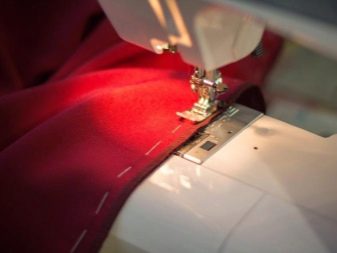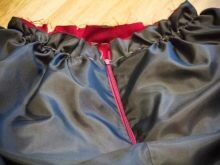Skirts with bow pleats
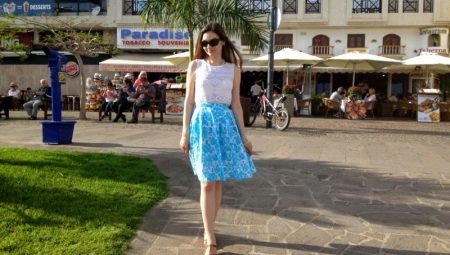
Pleated skirts and dresses are arguably the most feminine pieces of clothing, even though they were also part of European men's clothing centuries ago. At first glance, it seems that all pleated skirts are completely the same type, but in reality this is completely different. Professional seamstresses, clothing designers and fashion stylists recognize several types of folds that make things look completely different.

Today we want to tell you about skirts with bow pleats. After reading this article, you will learn what they are, what they can be worn with, and how to create such a skirt with your own hands.


Peculiarities
Bow folds are also called "counter" folds. This type of fold is different in that it looks different from the front and back sides.
If you look at the product from the front side, then the folds of the folds will look at each other, and if you turn it inside out, then they will be directed in different directions.
Typically, bow pleats are 5 to 12 cm wide.

Skirts with bow pleats are quite voluminous and voluminous, so they are not suitable for everyone. These models look best on slender girls with small hips.
In this case, the flared skirt only emphasizes the grace of the figure, while at the same time giving it a more feminine shape.



Overweight beauties should be more careful if they decide to purchase a similar skirt for their wardrobe. Curvy girls are advised to give preference to elongated models (no higher than the knee) on a hard yoke belt.

There are several options for skirts with bow pleats, which differ in cut features. The most interesting models are the "sun" and "semi-sun", as well as the "tatyanka".

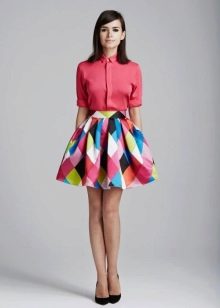

What to wear with?
A pleated skirt, regardless of the style, looks very flirty and feminine, so she requires accompanying clothes with the appropriate style and mood. These can be both business items from the work wardrobe, and ordinary everyday clothes.
However, if you put on a skirt with bow pleats with an elegant top and beautiful shoes, it is quite possible to appear in such an outfit at a gala event.




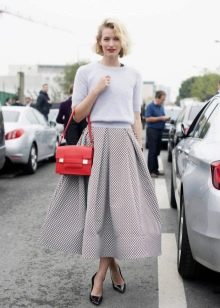
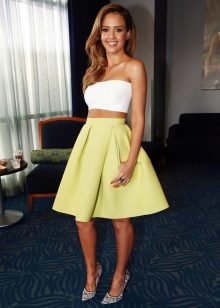
There is one important rule, according to which you need to choose a top of a simpler, calm silhouette for a fluffy skirt. Therefore, it is better to put long, voluminous things aside.
Instead of baggy clothes, you should give preference to things of a tight or semi-tight silhouette. Let it be a blouse, shirt, fitted jacket or sweater. In summer, you can choose an original top or a simple tank top as the top of your outfit.

The choice of shoes is yours, but since we are talking about a rather elegant, romantic style of the skirt, we would advise you to stay on models with heels - classic shoes, light sandals or graceful boots.
However, more comfortable shoes are also not contraindicated. Today, many women of fashion are not afraid to wear pleated skirts, even with sports shoes.

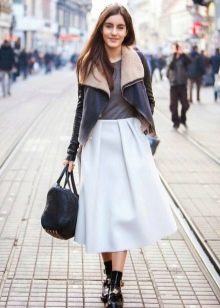

How to sew
Despite the seeming complexity of the style, sewing a skirt with bow pleats is a fairly simple task. To do this, you don't even need to make a pattern, all measurements are transferred directly to the fabric.

Necessary accessories for work:
- material;
- threads;
- tailor's scissors;
- tailor's meter;
- set of pins;
- adhesive fabric;
- lightning;
- crayon, a bar of soap, or a washable marker for line marking;
- hook clasp;
- sewing machine.


Calculation of bow folds
The most important thing when creating a skirt with bow pleats yourself is to correctly calculate the number and width of pleats.
To do this, you first need to take a few measurements:
- Determine the desired length of the skirt, then measure the waist and hips. To determine web width, from which we will sew a skirt, we multiply the hip circumference by three and add 3 cm to the resulting number, necessary for a free fit of the skirt. Then we add another 10-12 cm - this is an allowance. Blade length - this is the desired length of the skirt plus 6-8 cm of the margin for processing the bottom and top edges of the skirt.
- The next parameter to be calculated is the total depth of all folds products. It is determined by the following formula: the width of the canvas without allowance minus the hip circumference plus the margin for free fitting. Next, we define the depth of one fold: Divide the number obtained in the previous step by the desired number of folds.
- Distance between folds, or the width of one fold is determined by dividing the circumference of the hips, taking into account the free fit, by the number of folds.
- Next, we calculate how much fabric will go to grooveslocated at the waist. To do this, subtract the free-fitting waist circumference from the free-fitting hip coverage. Divide the result by the total number of folds, then by two more and get the depth of one fold at the waist.

Required patterns
The next stage of work is marking the fabric. Here we need the results of the calculations performed at the previous stage. The markings should be applied to both sides of the piece of fabric.
So, having laid out the material on a flat surface, we successively set aside from the edge and note the following values:
- seam allowance;
- a quarter of the depth of one fold;
- distance between folds;
- the depth of one fold;
- three quarters of the depth of one fold;
- seam allowance.
If the skirt will consist of two parts, then the markings must be applied to two pieces of fabric.

Sewing
- We sew the product along the side seams and hem the bottom edge, leaving 15 cm from each side.
- In accordance with the markings applied, fold the folds, fasten them with pins and sweep them.
- We iron the product through damp gauze on both sides, carefully fixing the folds with an iron. Removing the annotation.
- Finish the side seam and hem finishing.
- Depending on the fabric, we cut out and sew on the petticoat.
- We sew in a zipper.
- We process the upper edge of the product with a stitched belt. For this we use a strip of adhesive material.
The skirt with beautiful bow pleats is ready!

